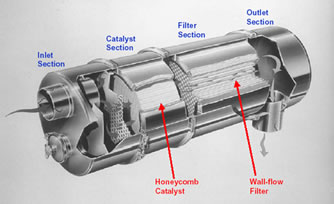 Retrofit
Retrofit
A retrofitted school bus is a cleaner school bus. It is cleaner because it either has been fitted with a device designed to reduce pollution and/or it uses a cleaner fuel. There are a variety of ways to retrofit a school bus. Retrofit options range in cost as well as effectiveness and some come with special requirements. EPA verifies retrofit technologies to ensure that they produce the emission reductions advertised by their manufacturers.
On this page
Technology
You will need Adobe Reader to view some of the files on this page. See EPA's PDF page to learn more.
Pollution Control Devices
Diesel Oxidation Catalysts
Diesel oxidation catalysts are devices that use a chemical process to break down pollutants in the exhaust stream into less harmful components. Diesel oxidation catalysts can reduce emissions of particulate matter (PM) by 20 percent and hydrocarbons (HC) by 50 percent and carbon monoxide (CO) by approximately 40 percent. Oxidation catalysts cost about $600 to $2,000, can be installed on any new or used bus, and run on regular diesel fuel. Although installation time can vary, field experience suggests it takes about 1 to 3 hours to install an oxidation catalyst.
Fact sheet: Diesel Oxidation Catalysts: Informational Update
 .
.
Diesel Particulate Matter Filters
Diesel particulate matter filters are ceramic devices that collect particulate matter in the exhaust stream. The high temperature of the exhaust heats the ceramic structure and allows the particles inside to break down (or oxidize) into less harmful components. They can be installed on new and used buses, but must be used in conjunction with ultra-low sulfur diesel (ULSD) - fuel with a sulfur content of less than 15 parts per million. The combination of PM filters and ULSD can reduce emissions of PM, HC, and CO by 60 to 90 percent.
PM filters come in a kit that includes mounting brackets and an electronic monitoring device. The cost of the kit can range from $5,000 to $10,000. Some buses may need the more expensive filters to compensate for lower exhaust temperatures. PM filters work best on engines built after 1995. As a result, knowing the age and type of each engine in the fleet as well as the drive cycles of the buses is an important part of any retrofit project. These factors determine whether or not buses are candidates for filters. Although installation time can vary, field experience suggests it takes about 6 to 8 hours to install the filter.
Cleaner Fuels
Ultra-Low Sulfur Diesel (ULSD)
ULSD will be available nationwide in October 2006, but currently is available in certain parts of the country. The primary purpose of ULSD is to enable or improve the performance of aftertreatment technologies such as a PM filter. The quantity of emissions reductions from the use of ULSD alone will vary depending on the application, level of sulfur reduction, and other fuel characteristics of the replacement fuel (e.g., cetane number, aromatics, PNA). Some case studies suggest that the use of ULSD alone can reduce emissions of PM between 5 and 9 percent. While ULSD-only emission reductions for PM are relatively modest on a per-vehicle basis compared to aftertreatment retrofit, the emission reductions can be significant if an entire fleet is fueled with ULSD.
Additional information on the roll-out of ULSD across the nation. For more information on good maintenance practices during the transition to ULSD from regular diesel fuel, visit the fleet maintenance page.
Biodiesel
Biodiesel is a domestically produced, renewable fuel that can be manufactured from new and used vegetable oils and animal fats. Biodiesel is safe, biodegradable, and reduces air pollutants such as PM, CO, HC and air toxics. However, emissions of NOx increase with the concentration of biodiesel in the fuel. Some biodiesel produces more NOx than others, and some additives have shown promise in modifying the increases.
Blends of 20% biodiesel with 80% petroleum diesel (B20) can be used in unmodified diesel engines. Biodiesel can be used in its pure form (B100), but may require certain engine modifications to avoid maintenance and performance problems. Pure blends of biodiesel may not be suitable for cold climates. B20 reduces emissions of PM by about 10 percent. However, B20 also increases NOx emissions by approximately 2%.
Emulsified Diesel
Emulsified diesel is a blended mixture of diesel fuel, water, and other additives that reduces emissions of PM as well as NOx. Emulsified diesel can be used in any diesel engine, but the addition of water reduces the energy content of the fuel, so some reduction in power and fuel economy can be expected. Emulsified fuel will stay mixed for a fairly long time. However, if a vehicle sits dormant for months at a time the water can settle out of the fuel and possibly cause problems. Therefore school buses may want to phase out the use of the fuel towards the end of the school year and then reintroduce it in the fall. Case studies suggest that emulsified diesel can reduce emissions of smog-causing NOx by about 10 - 20 percent and PM by about 50 - 60 percent.
For More Information
- Information about retrofit manufacturers.
- Basic information about retrofit verification.
![[logo] US EPA](https://webarchive.library.unt.edu/eot2008/20081019191616im_/http://www.epa.gov/epafiles/images/logo_epaseal.gif)